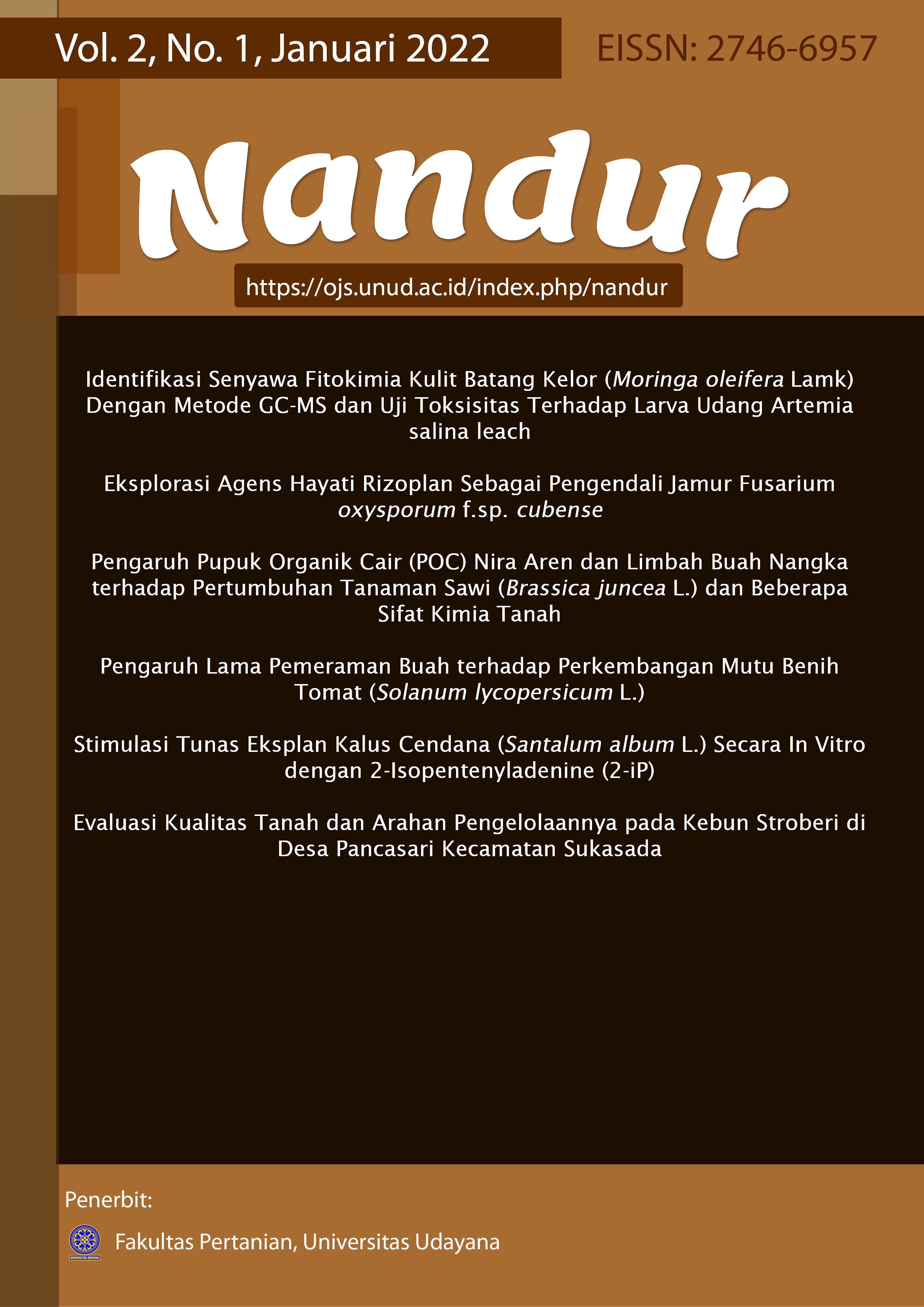Eksplorasi Agens Hayati Rizoplan Sebagai Pengendali Jamur Fusarium oxysporum f.sp. cubense
Abstract
Fusarium wild or wilt disease that attacks banana plants is caused by the pathogenic fungus Fusarium oxysporum f.sp. cubense This disease is difficult to control because it lasts a long time in the soil by forming chlamydospores. Currently, the control of this disease is still using synthetic fungicides, but this method can cause damage to the ecosystem. Biopesticide is one of the environmentally friendly control of plant pathogens because biopesticides use biological agents. The purpose of this study was to export rhizoplan bacteria from banana plant roots which have antifungal activity against F. oxysporum f.sp. cubense. The results showed that rhizoplan bacteria were able to inhibit the growth of Fusarium oxysporum f.sp. cubense fungal colonies on potato dextrose agar (PDA) media with an inhibitory percentage of 90.90% when compared to the control. The results of the bacterial filtrate test of rhizoplan at a concentration of 50% were able to inhibit the growth of the fungus Fusarium oxysporum f.sp. cubense with an inhibitory percentage of 92.72%.
References
Cazorla, F. M., D., Romero, A., Pérez‐García, B.J.J., Lugtenberg, A.D., Vicente & G., Bloemberg. (2007). Isolation and characterization of antagonistic Bacillus subtilis strains from the avocado displaying biocontrol activity. Journal of applied microbiology, 103(5), 1950-1959
Chernin, L., and L. Chet. 2002. Microbial enzymes in biocontrol of plant pathogens and pests, p. 171-225. In R. G. Burns and R. P. Dick (ed.), Enzymes in the environment: activity, ecology, and applications. Marcel Dekker, New York, N. Y
Dewi, N. (2015). Uji Antagonis Bakteri Rizosfer Pisang terhadap Cendawan Patogen Thizoctonia solani (Doctoral dissertation, Universitas Islam Negeri Alauddin Makassar).
Djohari, M., W.Y., Putri, & E., Pratiwi. (2019). Isolasi Dan Uji Aktivitas Daya Hambat Ekstrak Etanol Biji Pinang (Areca catechu L.) Terhadap Bakteri Pada Lidah. Jurnal Riset Kefarmasian Indonesia, 1(3), 177-188.
Fakultas Pertanian Universitas Udayana. 1999. Penelitian Penyakit Layu Tanaman Pisang Tersebar di 9 (sembilan) Dati II Bali. Laporan Hasil Penelitian. Fakultas Pertanian, Universitas Udayana Denpasar Bali.
Gohel, V., A., Singh, M., Vimal, P., Ashwini, & H.S., Chhatpar. (2006). Bioprospecting and antifungal potential of chitinolytic microorganisms. African Journal of Biotechnology, 5(2), 54-72.
Matsumoto, K.S. 2006. Fungal Chitinases, In: Guevara-Gonzales R.G and Torres-Pacheco I (Eds). Advances in Agricultural and Food Biotechnology. Reseach Signpost, India. 289-304.
Mavingui, P., & T., Heulin. 1994. In vitro chitinase and antifungal activity of a soil, rhizosphere and population of Bacillus polymyxa. Soil Biology and Biochemistry, 26(6), 801-803.
Nwe, N, T., Furuike, & H., Tamu. 2011. Chitin and Chitosan from Terrestrial Organisms. In; Kim S-K (Ed) Chitin, chitosan, oligosaccharides and their derivatives: biological activities and applications. New York: CRC Press Taylor & Francis Group
Rosmahani, L. 1999. Pengelolaan Hama dan Penyakit Pisang Cavendish. Buletin Teknologi dan Informasi Pertanian. BPTP Karangploso Malang. Vol. 2(1):1-5
Sarimole, E., M., Martosupono, H., Semangun, & J.C., Mangimbulude. (2014). Manfaat jarak pagar (Jatropha curcas) sebagai obat tradisional. In Prosiding Seminar Nasional Raja Ampat (pp. 9-12).
Saylendra, A., T.B., Rusbana, & L., Herdiani. (2018). Uji antagonis Pseudomonas sp. asal endofit perakaran padi terhadap penyakit blas (Pyricularia oryzae) secara in vitro. Agrologia, 4(2).
Suastika, I.B.K., & A.A.N.B., Kamandalu. 2005. Penggunaan Biopestisida Persada dan Pestisida Nabati dalam Uji Adaptasi Pengendalian Penyakit Layu Pisang di Provinsi Bali. Bali. Balai Pengkajian Teknologi Pertanian Bali.
Sudana, IM. 2004. Identifikasi Patogen Penyebab Penyakit Layu Pisang dan Tingkat Patogenisitasnya pada Beberapa Jenis Pisang Lokal. AGRITROP (Jurnal Ilmu-Ilmu Pertanian) Fakultas Pertanian Universitas Udayana Denpasar. Vol 23(3):82-87.
Sulyanti, E., Habazar, T., Husin, E. F., Nasir, N., & Dharma, A. (2020). Penapisan Isolat fungi mikoriza Arbuskular indigenus rizosfer pisang sebagai induser ketahanan tanaman pisang cavendish terhadap layu Fusarium (Fusarium oxysporum f. s.p. cubense). JURNAL AGROTROPIKA, 16(1).
Wibisono, Y., Savitri, D., Dewi, S. R., & Putranto, A. W. (2014). Ekstrasi Senyawa Fenolik Dari Bawang putih (Allium sativum L.) Untuk Agen Anti-Biofouling Pada Membran. Jurnal Ilmiah Rekayasa Pertanian dan Biosistem, 8(1), 100-109.



